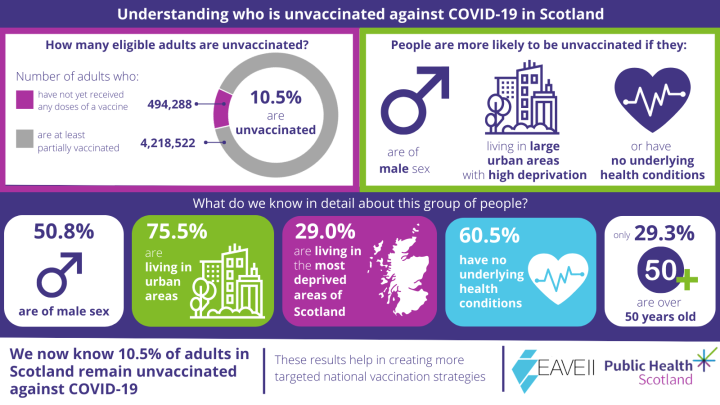Characterising adults in Scotland who are not vaccinated against COVID-19
September 2022: A Research Letter published in The Lancet looks at who has not yet been vaccinated for COVID-19 in Scotland.

Characterising adults in Scotland who are not vaccinated against COVID-19
Shahul, S; Hall, Elliott; Grange, Z; Sullivan, C; et. al
The Lancet Letters
Published online on: 22 September 2022
Available at: https://doi.org/10.1016/S0140-6736(22)01653-1
This infographic was created by the EAVE II's Communications & Engagement Officer, Gabriella Linning (Usher Institute, The University of Edinburgh)
Plain English Summary
The COVID-19 vaccine programme for adults began in the UK on 8 December 2020.
By 10 August 2022, around 4 in 5 adults living in Scotland had received at least three vaccine doses (79%, or around 3.5 million people). The remaining population have received up to two doses, or had no record of a vaccine being given at all. This research letter focuses on those who had not received any vaccine dose.
Why did we carry out this research?
There are many reasons why a person may not have received any doses of a COVID-19 vaccine. This may include difficulty accessing vaccines, uncertainty about having them, or inability to have them for medical reasons.
We wanted to understand who was completely unvaccinated – defined as having no COVID-19 vaccine record.
This research can help policy-makers understand gaps in vaccine coverage and inform future public health messaging. It can also provide useful information about groups that may not want to, or are unable to, access COVID-19 vaccines.
What data did we use?
To carry out this study, we used data from the Early Pandemic Evaluation and Enhanced Surveillance of COVID-19 (EAVE II) platform. This includes everyone registered with a GP in Scotland as of 1 March 2020. We included adults with no vaccination record, and excluded people in this group who were recorded by their GP as:
- Having left Scotland
- Having died before the vaccination programme started
- Not having any interaction with the NHS since 1 January 2019.
This left a population of 4,712,810 adults in Scotland who were eligible for COVID-19 vaccination.
What did we find?
We found 494,288 living people in Scotland who, on 10 August 2022, were:
- Eligible for a vaccine
- Had no COVID-19 vaccine record
- Had been in contact with the NHS at least once since 1 January 2019.
This number excludes anyone who was recorded as ‘contraindicated’. This means they could not have the vaccine for medical reasons.
Describing the group
There were similar numbers of unvaccinated men and women in each of the age ranges we looked at. The average age was 42.4 years. The majority of unvaccinated people live in urban areas, and the largest proportion (29%) live in the most deprived areas of Scotland.
Most unvaccinated people (60.5%) had no underlying health conditions recorded. However, a significant number (11.2%) had three or more underlying conditions recorded. As has previously been shown, this group is at higher risk of serious COVID-19 illness.
One in five of the unvaccinated group (20.9%) were prescribed medications for conditions related to the central nervous system (‘CNS’, nerves in the brain and spine). We also found that more than a third of the people on CNS medication (38.8%) were also prescribed anti-depressants.
Limitations of the study
We were not able to include ethnicity data in our study. We recognise that ethnicity is linked to variations in vaccine uptake – this has been shown by studies done elsewhere in the UK. In addition, we did not have records for people vaccinated outside of Scotland.
Why is this research important?
Our study has shown that, within the limits of the data available to us, a higher than normal proportion of unvaccinated people in Scotland:
- live in an urban area
- live in areas of high deprivation
- have medication for CNS conditions.
This study also highlighted that over 55,000 people with three or more underlying health conditions haven’t had a COVID-19 vaccine yet. This group is at higher risk of serious COVID-19 illness.
This study is the first of its kind in the country. It can be used to help provide better access to COVID-19 vaccines and targeted campaigns for the Scottish population.
Note
This plain English summary was written by our Patient and Public Involvement Lead Lana Woolford, with the support and feedback of the EAVE II Public Advisory Group (PAG) and researchers. This particular summary was reviewed by PAG member David W.


